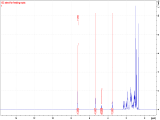Bruker Topspin NMR files for 13C-labeled sterols used for metabolic studies analyzed in Syracuse, NY during 2011 (PhytosterolsZooplank project)
Project
| Contributors | Affiliation | Role |
|---|---|---|
| Giner, Jose | State University of New York College of Environmental Science and Forestry (SUNY ESF) | Principal Investigator |
| Copley, Nancy | Woods Hole Oceanographic Institution (WHOI BCO-DMO) | BCO-DMO Data Manager |
This dataset includes NMR results 13C-labeled sterols used for metabolic studies of the Northern Bay scallop, Argopecten irradians irradians. The zipped files may also be downloaded here: https://datadocs.bco-dmo.org/d3/data/giner_nmr/13C-sterols.zip (16.4 GB).
These data were published in Giner et al (2016).
The spectra were acquired using a Bruker Avance-600 instrument at 30 °C using CDCl3 as the solvent. The data was processed using Bruker Topspin. See Giner et al (2016) for details.
| File |
|---|
13C_sterols.csv (Comma Separated Values (.csv), 103 bytes) MD5:01cdf7511a877c4f251dc2ddb2cb1e2b Primary data file for dataset ID 565297 |
| Parameter | Description | Units |
| file_link | Link to the compressed data file. |
| Dataset-specific Instrument Name | NMR |
| Generic Instrument Name | Nuclear Magnetic Resonance Spectrometers |
| Dataset-specific Description | Instrument: Bruker Avance 600 Bruker Topspin NMR software packege used for the data analysis: https://www.bruker.com/products/mr/nmr/nmr-software/software/topspin/ove... |
| Generic Instrument Description | Instruments that identify and quantify magnetically active chemical entities by subjecting a sample to orthogonal magnetic and electrical fields. |
Giner_lab
| Website | |
| Platform | SUNY-ESF |
| Start Date | 2011-01-18 |
| End Date | 2016-03-31 |
| Description | Chemical analysis of algae |
Collaborative Research: Effects of Marine Algal Sterols on Zooplankton Growth and Reproduction (PhytosterolsZooplank)
Description from NSF award abstract:
Autotroph-herbivore interactions in marine food webs are important to fisheries, the global carbon cycle, and, because of harmful algal blooms, human health. The recent hypothesis that harmful algae interfere with the growth and reproduction of zooplankton because of specific structural modifications of the algal sterols will be tested in research on the roles of nutritional factors in planktonic food webs. The effects of marine algal sterols on herbivorous crustaceans will be investigated in three calanoid copepods, Acartia hudsonica, Eurytemora affinis, and Calanus finmarchicus, and brine shrimp, Artemia salina. In this project, studies will be carried out to determine whether marine algal sterols can be metabolized to cholesterol by zooplankton and the relative efficiency of this process. This information is critical for assessing the nutritional value of different algal diets. Using the metabolic studies as a foundation, further experiments will seek to determine whether selected sterols, some of which have structural similarities to steroid hormones, have an inhibitory impact on the growth and reproduction of crustaceans. The analytical techniques used in these experiments will be high-field 13C-nuclear magnetic resonance spectrometry (NMR) and gas chromatography-high resolution mass spectrometry (GC-HRMS). Test sterols for these experiments will be labeled with stable isotopes (13C and 2H) in specific positions by chemical synthesis.
| Funding Source | Award |
|---|---|
| NSF Division of Ocean Sciences (NSF OCE) |
[ table of contents | back to top ]
